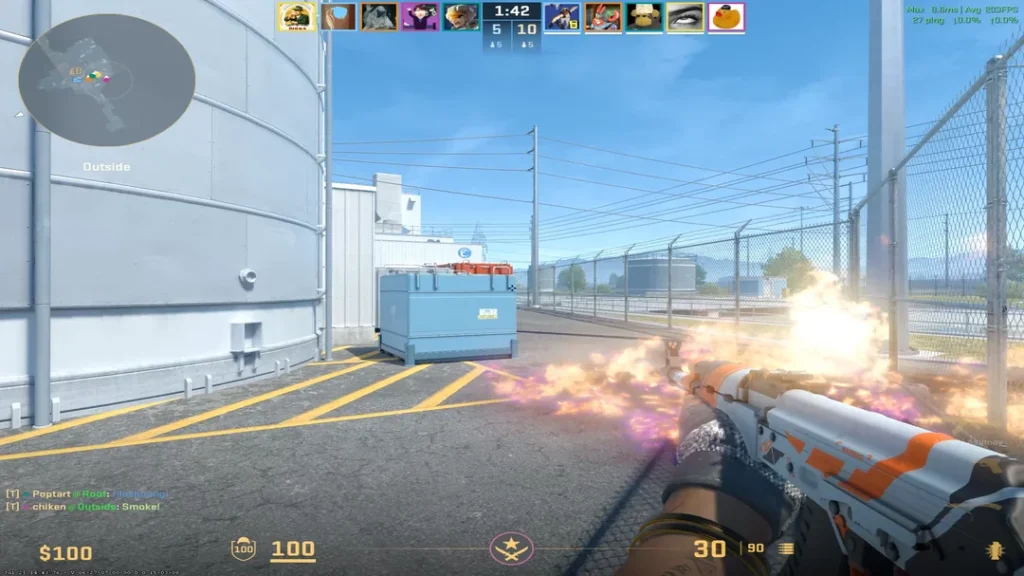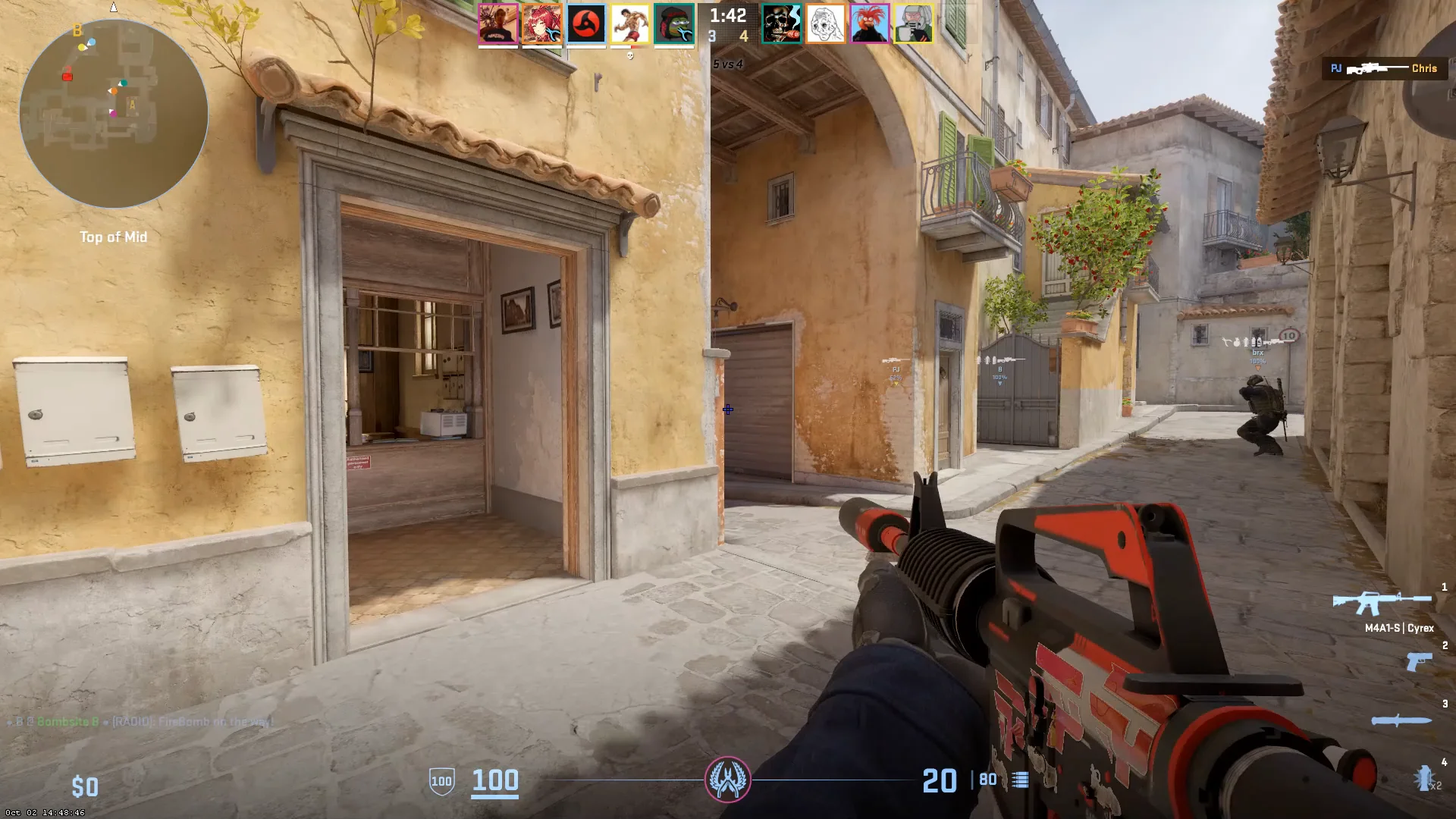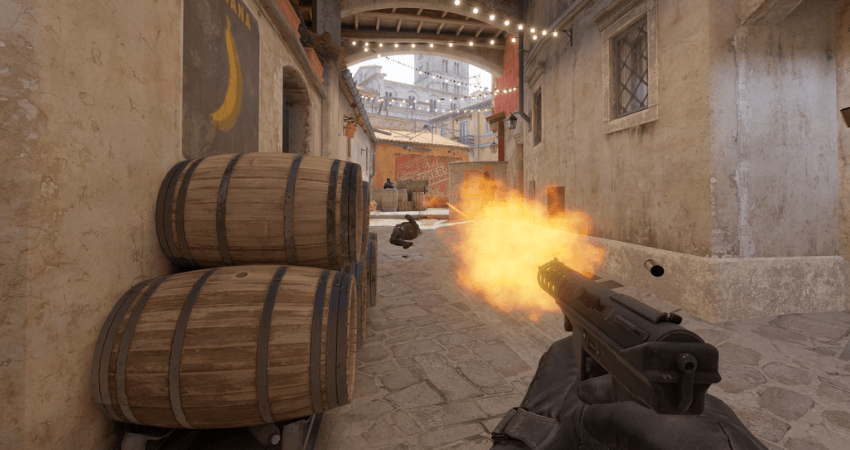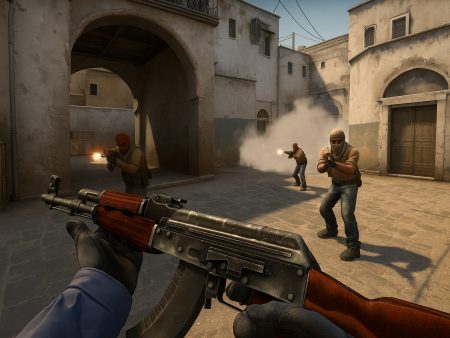Master the art of off-timing in CS2 with this in-depth guide. Learn advanced strategies, role-based tips, map-specific tactics, and how to outsmart opponents by breaking predictable patterns. Perfect for competitive players aiming to play smarter, not just faster.
If you’ve ever played a game of Counter-Strike 2 and wondered how some players seem to always be in the right place at the wrong time—for you—chances are, you’ve been outplayed with off-timing. This high-level tactic isn’t just random movement or lucky guesses; it’s a deliberate strategy used by elite players to disrupt patterns, catch opponents off guard, and create openings in even the most locked-down defenses.
Mastering off-timing can give you a huge edge in competitive play, especially when both teams are evenly matched in aim and utility. This article will break down everything you need to know—from the psychology behind off-timing to advanced team strategies and map-specific tips. Let’s dive in.
Understanding the Concept of Off-Timing
What Is Off-Timing in CS2?

Off-timing is all about doing something unexpected—deliberately going against typical timing patterns or movements in a match. It’s about being unpredictable in a game where predictability often leads to death. Whether it’s walking up mid a few seconds later than normal or holding a position for an unusually long time, off-timing is designed to exploit your opponent’s expectations.
In CS2, where rounds are often decided by milliseconds and footsteps, the difference between normal timing and off-timing can be the deciding factor between a clean entry frag or getting pre-fired before peeking a corner. A simple example: instead of pushing Banana on Inferno as soon as the round starts, you might wait until 1:10 on the clock—when your opponents have likely fallen back or rotated—and then walk up silently. This throws off their mental timing and increases your odds of surprising them.
Why Off-Timing Matters in Competitive Play

In higher levels of CS2, players are extremely disciplined and often memorize standard timings for every push, rotation, and hold. This is where off-timing shines—it breaks the pattern.
- Unpredictability Equals Power: When your movement doesn’t match the rhythm of the round, opponents have a harder time pre-aiming or anticipating your position.
- Mind Games: Off-timing introduces doubt. If a player expects you to push at 1:45 and you wait until 1:30, they might rotate early, give up a key position, or overthink their play.
- Improved Map Control: You can regain control of contested areas or sneak into vital positions simply because the enemy has already “cleared” it in their mind based on default timings.
Off-timing is a subtle but deadly weapon. Used correctly, it turns the tide of rounds, especially in clutches, eco rounds, and fake plays.
The Psychology Behind Off-Timing
How Opponents Anticipate Movements

In most competitive games, players rely heavily on routine and game sense to make decisions. They learn over time that a player might reach a chokepoint by a specific time, that certain angles are usually held at certain moments, and that footsteps mean aggression. These mental shortcuts are what make high-level play possible—it’s how players react in split-seconds.
But once you throw off those timings, everything changes. Your opponent might:
- Peek too early or late, expecting you to be there when you’re not.
- Rotate away from your site, assuming the hit is done.
- Overpeek or underpeek, due to uncertainty.
This mental disruption can cause hesitation or misplays—exactly what you want.
Exploiting Predictability with Off-Timing
Let’s say you’re playing as a lurker on T-side. If you always push your lane at the same point in the round, you’re easy to predict. But if you mix it up—push early some rounds, go late on others, or hold completely still for 30 seconds—you become a nightmare to read.
Predictability is a liability in CS2. When you exploit your enemy’s expectations, you force them into a reactive state. You’re no longer playing their game; they’re playing yours.
In fact, some of the best players in the world, like NiKo or s1mple, are masters of off-timing because they understand and manipulate opponent habits. They know that success in CS2 isn’t just about sharp aim—it’s about staying one step ahead mentally.
Mastering the Basics of Movement and Timing

Learning Default Timings First
Before you can manipulate timing, you need to understand it. This means learning the default timings for:
- Pushing lanes from spawn.
- Rotations from site to site.
- Utility timings like initial smokes, flashes, and mollies.
This foundational knowledge helps you know what your opponent expects—and how to go against it.
For instance, if it takes 15 seconds to reach Long A from T-spawn on Dust II, your opponents are likely holding their angles during that window. But if you delay that peek by even five seconds, they might have moved, lost focus, or turned away. That’s your moment.
Building Awareness of Opponent Rotations
A big part of off-timing is understanding the enemy’s timing too. Watch how they rotate based on sound cues or utility usage. If they fall back every time you throw a fake, you can plan a delayed push or flank right after they leave.
Timing your movements with their rotations can win you rounds. You’re not just avoiding a fight—you’re attacking when the enemy is at their weakest.
Recognizing Choke Points and Key Engagement Zones
Choke points are high-traffic areas where standard timings dominate. Learning to approach these with an off-timing mindset can win you early-round picks or entry control.
Examples include:
- Inferno Banana
- Mirage A Ramp
- Nuke Ramp or Outside
Instead of peeking these instantly, try walking in 15 seconds later. Or better yet, wait behind a molotov and go in right after it fades. These small shifts can completely change the outcome of an engagement.
How to Apply Off-Timing Strategies in Practice
Walking Instead of Running – Sound Cues Matter
Running makes noise, and noise gives information. Off-timing often involves manipulating sound—walking when others would run, or even making noise deliberately to fake a rotate.
For example:
- Walk through a smoke to catch an AWPer off-guard.
- Walk to a flank position after a fake, catching enemies rotating.
- Run away loudly to bait a rotate, then walk back silently for a backstab.
Sound in CS2 is crucial, and using it unpredictably is one of the smartest ways to create off-timing opportunities.
Off-Timing for Different Roles in CS2
Entry Fraggers: When to Delay or Accelerate Pushes
Entry fraggers are the front-liners of every T-side push. Their job is to crack open bomb sites and win duels. But even this aggressive role can benefit massively from off-timing. Most players assume that entry fraggers must be fast and consistent. However, deliberately delaying your push or speeding it up unexpectedly can be the difference between getting an opening kill or walking into a crossfire.
Let’s break it down: if you always rush out Palace on Mirage at the 1:40 mark, you become readable. The defenders will pre-nade or pre-aim that timing, and you’ll likely run into a setup. But if you sometimes wait behind cover until 1:25, peek out slowly, or swing when your teammates are already causing chaos elsewhere, you change the rhythm. Now defenders are distracted, repositioning, or clearing angles they shouldn’t be. You become a ghost that appears when they least expect it.
Another effective tactic for entry players is the “fake delay”—start like you’re going to execute at the standard timing, bait out utility or reactions, then pull back and re-engage 10–15 seconds later. Defenders often let their guard down in that small window.
Using off-timing as an entry isn’t about hesitation—it’s about being intelligently unpredictable. Don’t become the guy who always goes first at the same time. Be the entry who adapts, adjusts, and surprises.
Lurkers: The Kings of Off-Timing
If any role thrives off off-timing, it’s the lurker. Lurkers exist in the shadows—pushing flanks, controlling rotations, and sniffing out openings when the enemy thinks they’re safe. Great lurkers like EliGE, ropz, or f0rest have made careers from manipulating timings and punishing lazy clears or over-rotations.
The key to being a successful lurker is patience. Not the kind of patience where you sit in one spot all round, but the kind that lets you feel the timing of a round. A good lurker waits—not just for the right second to strike, but for the wrong second in the enemy’s mind.
Here’s an example: you’re lurking B Apartments on Mirage. Your team throws utility toward A and begins a fake. Instead of rushing out right after, wait. Walk the edge of apps silently, listen for rotations, and strike once the B defender peeks mid or turns to rotate. Your timing here is deadly—not fast, not slow, but misleading.
Lurkers should avoid robotic plays. Don’t always push late. Don’t always wait. Change it up. Leave gaps between footsteps. Hold angles longer than usual. The more erratic and thoughtful your timing, the more valuable you become.
AWPers: Unexpected Repositions and Rotates
AWPers might seem less reliant on off-timing due to the nature of their weapon—one shot, one kill. But in reality, AWPers who master off-timing are among the most fearsome players in CS2. Why? Because they’re not just aiming at angles—they’re predicting when someone thinks it’s safe.
A great AWP off-timing example is rotating off an angle just a few seconds before an opponent peeks it. Let’s say you’re holding Top Mid on Mirage and after 20 seconds you fall back and post up on Catwalk instead. An enemy who delayed his peek will now walk into your new angle, thinking mid is clear or unguarded. That’s where you catch them off guard.
Similarly, aggressive AWPers can make off-timing work by pushing forward just after the opponent clears or peeks an angle. Imagine walking down Banana on Inferno right after a molly fades or re-peeking Mid on Dust II a full 10 seconds after your first engagement. These odd movements force your opponent to reset their mental timer, and many players don’t have the awareness to anticipate a second peak that late.
The key for AWPers is to think in patterns—then break them. Reposition unexpectedly, double-scope where others wouldn’t, or hold an angle 20 seconds longer than usual. Time is your ally when used against your enemy’s habits.
Off-Timing on T Side vs CT Side
T Side: Faking Map Control and Delayed Hits
On the T side, you dictate the pace of the round. That means you have far more opportunities to play with off-timing—especially with map control and executes. The most basic version of off-timing on T side is faking presence: throwing smokes or nades to suggest a push, then silently backing off.
For example, throw your usual Top Mid smoke on Mirage, but instead of peeking or following it up, walk back toward B. The CTs, expecting pressure, may rotate a player or waste utility on mid, giving you a softer hit on B. Similarly, throwing a full execute on A but walking back to hit B 15 seconds later plays directly into off-timing.
Delayed hits are another powerful T-side weapon. Most CTs are trained to hold positions until a certain point in the round. If nothing happens, they rotate or reposition. So if you push just after that timing—say, 30 seconds after mid pressure—they’ll likely be caught in transition.
T side off-timing requires coordination. Don’t solo-delay unless you’re lurking. As a team, agree to hold utility, wait for audio cues, then strike when the defenders feel most secure. It’s a game of when, not just where.
CT Side: Aggressive Re-Peeks and Pushes at Odd Moments
On CT side, off-timing plays are riskier—but often more rewarding. Since you’re defending, your opponents expect you to hold angles, fall back with utility, or rotate predictably. Off-timing CTs break that mold by pushing or peeking at unusual times.
Here’s the catch: you have to commit. For instance, instead of falling back after initial Banana control on Inferno, walk forward and peek again after 10 seconds of silence. Most Ts will assume you gave up the angle. That’s your moment.
Another classic CT off-timing move is a delayed flank. Say you’re B site Mirage, and you hear an A take. Most players rotate fast or stay. But what if you wait 10 seconds, then push B Apps for a full backstab? It’s dangerous—but if timed right, it can win rounds single-handedly.
CT side off-timing relies on game sense and communication. You need to read your opponents’ pacing and adjust. Push when they think you’re gone. Hold when they expect you to rotate. Be the anomaly in their expectations.
Utility Usage and Off-Timing
Delayed Flashes and Nades
Utility isn’t just for initiating fights. When timed cleverly, it can be a massive off-timing tool. Instead of using all your nades at the start of the round, hold one flash or molly to use 10-20 seconds later. Most opponents won’t expect it, and it disrupts their mental rhythm.
Let’s say you’re on CT side Inferno. Instead of mollying Banana at 1:50 like everyone else, try throwing it at 1:20. The T side might be grouping for a push at that time, thinking the utility is gone. Now you’ve thrown off their execute, wasted their time, and possibly forced them to rotate or use utility early.
Delayed flashes can also be excellent for catching lurkers or post-plant positions. Don’t just spam flashes randomly—listen, wait, and use them when enemies least expect it.
Counter-Utility at Unusual Intervals
Most players are conditioned to expect counter-nades during executes—not 10 seconds after. That’s your window to strike. If you hear a fake, don’t use your smoke right away. Wait. Force them to commit to their fake or waste time.
The same goes for smokes. A well-timed late smoke can stall a push entirely. Or even better—throw the smoke, then push through it after a few seconds. That’s the ultimate off-timing move, and it punishes lazy clears or poor spacing.
Using off-timing with utility is about making your opponents uncomfortable. Delay, deceive, disrupt. Every nade can be a question mark that makes them second-guess their plan.
Game Sense and Experience: Developing the Feel for Off-Timing
Watching Demos of Pros and Analyzing Patterns
One of the fastest ways to improve your understanding of off-timing is by watching how professional players use it in real matches. But it’s not just about watching for flashy shots—pay attention to what they don’t do. The best players often win rounds not because they’re faster, but because they’re slower, more patient, and smarter with when they act.
Take ropz, for example. He’s notorious for holding unusual timings, walking into bomb sites 20 seconds after his team fakes pressure elsewhere. When you watch a demo, pause and ask yourself: Why did he wait there? What made him move now instead of earlier?
Look for these patterns:
- How long a player holds an angle before rotating.
- When they choose to flank—immediately or after a delay.
- How they respond to early round utility.
- When they fake steps or pause entirely.
Make notes or clip moments where timing directly leads to a kill or opening. Over time, you’ll notice that the most successful players aren’t robotic—they’re opportunists. And the key to their opportunities is timing.
Try reviewing demos not only from the pro’s perspective but also from their opponent’s POV. You’ll see how devastating an off-timed peek or flank feels when the defender simply isn’t ready. That perspective shift builds your own intuition on how to apply it in your games.
Learning from Your Own Games
While pro demos are invaluable, your own gameplay is a goldmine of learning opportunities—if you know what to look for. CS2’s demo viewer or third-party tools let you rewind, pause, and break down every engagement. Focus on deaths where you felt “caught off guard” or moments you should have gotten a kill but didn’t.
Ask:
- Was my peek too obvious?
- Did I follow a pattern I usually use?
- Was I too early or too late?
- Could I have waited for sound or teammate info?
You’ll be shocked how many deaths happen not because of bad aim—but because you followed expected timing. Recognizing that lets you experiment with delay, fake movement, or repositioning in future games.
Build a habit: after every match, review one or two rounds where your timing felt off. Adjust your rhythm the next time you play that map. Over time, you’ll build a natural “feel” for when to move and when to wait—a sixth sense that separates good players from great ones.
Common Mistakes to Avoid When Playing Off-Timing
Overcommitting to Unorthodox Plays
It’s easy to get addicted to off-timing—after all, it feels amazing when it works. But one of the most common traps players fall into is overcommitting to “weird” plays, thinking that being unexpected is always the best move. Here’s the truth: off-timing only works when your opponent has expectations to break.
If you constantly walk late, delay pushes, or rotate slow every round, guess what? That becomes your new pattern. Smart opponents will adjust and punish you. The power of off-timing lies in unpredictability, not in always being slow or sneaky.
Don’t make the mistake of trying to force an off-timing play every round. Sometimes, the standard timing is the best timing—especially if it surprises your opponent who’s expecting you to delay. Balance is key. Mix standard plays with unexpected ones.
Another mistake is pushing through smokes or walking into off-angles without proper info. Just because a play is “unusual” doesn’t make it smart. If your opponents haven’t shown signs of rotating or overcommitting, your delayed flank might end up being completely useless—or worse, getting you killed without impact.
Misreading Enemy Behavior
Off-timing requires reading the room, and that means accurately interpreting your enemy’s tendencies. If you assume they rotate early every round and they don’t, your delayed push becomes a suicide mission. Likewise, if you hold a position waiting for a flank that never comes, you waste precious time.
Pay attention to how your opponents react round after round:
- Do they rotate on a single smoke?
- Are they aggressive with early info?
- Do they hold utility or spam it instantly?
Misreading these cues leads to poorly timed plays, where your off-timing feels more like hesitation than strategy. The fix? Be adaptable. If your off-timing works once, change it the next round. Don’t rely on one tempo. Think jazz, not metronome—fluid and reactive.
Practicing Off-Timing in Different Scenarios
Deathmatch vs Custom Games
You might be thinking, “How do I practice something as fluid as timing?” Good news: you can build off-timing skills through focused routines—just not in the way you’d train aim.
Deathmatch, for instance, helps develop reaction speed and awareness. But don’t just run and gun. Use it to practice:
- Holding angles longer than usual.
- Re-peeking at off moments (like 2–3 seconds after breaking a duel).
- Sound-baiting with movement to fake off-timings.
While deathmatch can feel chaotic, it’s useful for experimenting with timings in micro-engagements. Try entering areas late or pushing angles after a delay and see how players react.
For more controlled practice, custom servers or private matches with bots or friends are ideal. Set up common engagement scenarios (e.g., mid to B pushes on Mirage) and practice walking in at different intervals. Record and review your rounds to see which timings feel “off” in a good way.
Also, use workshop maps to practice walking through smokes, baiting footsteps, or learning how long it takes to rotate from point A to B. Timing awareness starts with repetition.
Reviewing Demo Footage for Timing Clues
After practice, review. Watch demos of your own games to identify moments when:
- You rushed into stacked defenses.
- You were picked off after holding too long.
- You missed an opening because of over-delaying.
Then, adjust. The beauty of off-timing is that no two matches will require the same rhythm. The more you reflect and refine, the sharper your instincts become.
Advanced Off-Timing Strategies
Stacking Baits and Rotations
One of the more advanced uses of off-timing comes from coordination: deliberately stacking or baiting rotations as a team. This isn’t something you can do in PUGs easily—it requires synergy, communication, and practice.
Here’s how it works: you throw early utility toward one site (A, for example), then stack players outside the other site (B) in silence. After 15–20 seconds, you begin the real hit. But here’s the twist—just before the hit, one player fakes presence back on A again, causing another rotation or hesitation. This triple-layered off-timing forces defenders to second-guess themselves constantly.
Another great trick is the “bait delay”—where one player deliberately dies early with no trade, only for the rest of the team to execute 20 seconds later. It sounds counterintuitive, but when used with purpose, it causes defenders to relax, thinking they’ve thwarted a solo push. Then the real hit arrives with full force.
It’s risky. But when pulled off, these stacked off-timing plays look like magic. Teams like Vitality and NaVi use them often in pro play.
Using Sound Deception and Movement Tricks
Sound deception is the cherry on top of off-timing. Making noise where you aren’t going, jumping in place, or dropping fake weapons are all ways to bait attention.
Some sneaky tricks:
- Drop your pistol to fake a teammate’s presence.
- Jump-spam a ladder or surface to simulate movement.
- Run loud, then walk the opposite direction.
These tricks mess with your opponent’s sound-based game sense. Use them wisely to create layers of misinformation—especially when paired with actual off-timing plays.
Map-Specific Off-Timing Tips
Mirage: Underpass Walks and A Ramp Fakes
Mirage is a perfect map to practice off-timing due to its flexible rotations and chokepoints. One underrated trick? Underpass walks. Instead of hitting Mid instantly, go T-Spawn to Underpass and walk through at around 1:10. CTs often relax mid control by then, assuming you’re rotating or stalling.
Another classic is the A Ramp fake. Toss a smoke, flash, and even peek a shoulder to bait defenders into thinking it’s a rush. Then back off and regroup mid. By the time they realize it’s a fake, you’re taking Connector control or even hitting B.
Delayed Palace exits can also catch CTs rotating or repositioning. Combine slow movements with fast re-engagements, and you’ll control the pace of the map.
Inferno: Banana Control and Arch Re-Peeks
Inferno is one of the most timing-sensitive maps in CS2. Everyone expects early Banana utility fights, quick A pushes, and fast mid peeks. This expectation is your playground.
Let’s start with Banana control. Instead of the usual 1:45 rush for logs or car, try playing it differently. Walk up to half-wall at 1:30, listen for footsteps or nade usage, then either fall back or push in when the CTs think you’re gone. If they’ve used their molly or HE and rotated a player, you’re walking into a weakened setup.
Another strong off-timing move is the Arch re-peek. Let’s say you’re on CT side and the Ts are pressuring mid. After falling back, wait 5–10 seconds, then walk back into Arch and surprise a mid-lurker or someone lining up a smoke. They’ll never expect you to return after giving it up.
Late-round B hits, especially at the 30-second mark after faking A, can devastate unprepared CTs. And as a CT, walking up mid after an early A exec noise, when the Ts are planting or rotating, gives you flank timing gold.
Timing on Inferno is like dancing in the dark. One wrong step, and you’re dead. But one off-beat move? That’s a round stealer.
Nuke: Timing Vents and Squeaky Door Pushes
Nuke’s verticality makes off-timing even more powerful—and more punishing if misused. A classic move on Nuke is the vent drop fake. Make noise at Squeaky, maybe even throw a smoke or flash, then pause. Wait until the CTs shift position or rotate, and then make your move.
Another high-reward tactic is the delayed outside cross. Instead of rushing with smokes at 1:45, throw the wall and pause. Let the AWP fall off or rotate. Then, walk behind the wall 10 seconds later and punish a careless rotate or flank.
And don’t overlook Squeaky push delays. Hold Squeaky silently until just before a site hit. When your team hits Heaven or Main, you burst through—unexpected, unseen, and decisive.
How to Train Off-Timing as a Team
Team Drills for Desyncing Timings
Training off-timing as a team isn’t about running executes faster—it’s about running them smarter. One of the most effective drills you can use is the desync push: every player on your team enters a site at a slightly different interval, not all at once.
This makes defenders’ crosshairs constantly shift. Instead of a clean spray transfer, they’re forced to readjust mid-fight, giving your team the edge. Practice site takes where your entry, trade, and lurker all hit different timings within 3–5 seconds.
Another great drill is the delayed lurk execution. While your team executes A, the lurker walks to B—10 seconds after all utility is thrown. Your job as a team is to condition the defenders to believe you’re always 5-man hitting. Once that belief is broken, your lurker becomes deadly.
Communication is key in these drills. Call out timing, movement, and utility syncs precisely. Even a 2-second delay can flip a round.
Coordinating Lurks and Fakes
Coordination is what separates a “lucky off-timing” from a deadly strat. Lurks and fakes need to align perfectly—not just in location, but in rhythm.
Have your lurker start walking at the 30-second mark—only after your fake has pulled a rotate. If the fake’s too early, the timing falls apart. If it’s too late, your lurker gets isolated.
Use practice time to run these setups:
- A site fake + B lurk punish.
- Utility draw on mid + silent Palace creep.
- Delayed B hit after early A aggression.
It’s like composing music—each player’s movement is a note. When timed right, it’s a symphony of surprise.
Tools and Resources to Improve Timing Awareness
CS2 Demos, Third-Party Tools, and Server Mods
Want to level up fast? Use your tools. Start with demo reviews using CS2’s built-in replay system. Watch not just yourself, but others—especially players who outplayed you.
Look for:
- Timing on rotates.
- Entry delays.
- Flank timings.
- Post-plant movement.
Third-party tools like Leetify, Scope.gg, and CSGO Demo Manager can give stats on kill timing, rotations, and even heatmaps of movement. Use this data to study patterns—both yours and your enemies’.
Server mods can help simulate real-world conditions for timing. Use bot servers with mp_roundtime_defuse 60 to simulate full-length rounds. Walk through the map and measure how long it takes to rotate silently from A to B, or mid to site. This builds your internal timing clock.
Streamers and Pro Guides Worth Following
Learn from the masters. Some top-tier CS2 streamers and pros are open about their thought processes, often explaining why they peeked when they did.
Watch players like:
- ropz (master lurker with surgical timing).
- s1mple (mixes aggro and passive off-timing with AWP).
- NiKo (entry timing genius).
- rain (flank god).
Check YouTube guides from channels like NartOutHere, TheWarOwl, and BananaGaming. Many have in-depth strategy breakdowns where off-timing is a key factor.
Don’t just watch for fun—watch to absorb. Rewind, take notes, and test what you learn in your next game.
Conclusion
Off-timing isn’t just a niche tactic—it’s a philosophy. It’s the art of being one step behind to be two steps ahead. It’s the skill of manipulating your opponent’s expectations, of breaking their rhythm, of showing up when and where you’re least expected.
CS2, like life, rewards those who think differently. The players who rise above average aren’t just better shots—they’re better thinkers. They understand that timing isn’t just about when to peek, but when not to. It’s not about being fast—it’s about being right.
Start small. Delay a push. Hold an angle longer than usual. Watch how enemies respond. Build your own mental map of default timings and experiment with breaking them. The more you play with timing, the more you’ll see its invisible hand guiding every round.
And remember: just because it’s off, doesn’t mean it’s wrong.
FAQs
What is the best role for learning off-timing?
The lurker role is ideal for learning off-timing. It allows you to control your movement, manipulate rotates, and flank when enemies least expect it.
How can I fake my timing to confuse enemies?
Use sound to bait movement, delay your peeks, and reposition after noise. Fake footsteps, drop items, or run and walk in unpredictable patterns to create timing confusion.
Can off-timing backfire in high-rank games?
Yes, especially if overused. Higher-level players adjust quickly. If you become predictable with unpredictability, you’ll get punished. Always vary your timings.
How often should I use off-timing in a match?
Sparingly—but deliberately. Off-timing works best when it breaks a pattern. Use it 3–4 rounds per half, and always change your pace afterward to avoid being read.
Do pro players use off-timing strategies regularly?
Absolutely. Watch any pro demo, and you’ll see players like ropz, NiKo, and s1mple using timing manipulation to catch enemies off guard. It’s a foundational part of top-tier play.












